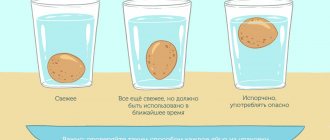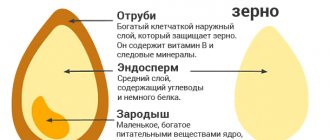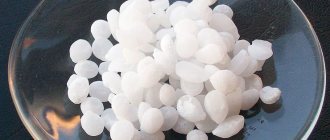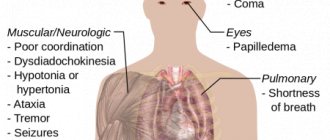- Preparation of insoluble bases
- Effect of bases on indicators
- Preparation of water-soluble bases
Bases, like oxides, acids and salts, belong to complex inorganic substances. Let's find out what parts the formula of any base consists of, using the following series of formulas:
Let's divide the formulas with a dash into two parts, separating the symbol of the metal element from the rest of the symbols, and write its valency above the metal:
Common to all formulas is the presence of a group of atoms called a hydroxyl group. In the first formula it is written without brackets, and in the remaining formulas it is enclosed in brackets, followed by the corresponding index.
As you already know, the concept of valency extends to groups of atoms, in particular to acidic residues. The hydroxyl group also has its own valency. It is monovalent. Pay attention to the valency of the metal in the given formulas, and it will become clear that the presence of indices is related to the valency of the metal. Indeed, monovalent potassium is connected to one hydroxyl group, divalent calcium and barium - to two, and trivalent aluminum - to three. Therefore, in order to comply with the rule regarding the same sum of valence units of both parts of the formula of a complex substance, the corresponding indices are placed.
Now we can formulate a definition of grounds:
Bases are complex substances formed by a metal element and hydroxyl groups.
Let's write the base formula in general form:
It should be noted that bases, like salts, are substances of ionic rather than molecular structure, therefore their formulas reflect the ratio of metal ions and hydroxyl group ions in the substance.
What is an acid?
Acids are molecules that, when dissolved in water, release a hydrogen ion. Ions are positively and negatively charged particles that give acids their properties.
Hydrochloric acid molecule
Let's look at this process using the example of hydrochloric acid - HCI. If hydrochloric acid is combined with water, it will break down into a hydrogen ion (H+) and a chloride ion (CI). Since the water molecule also contains hydrogen, when hydrochloric acid decomposes, the total number of hydrogen ions in the solution will increase.
What happens to alkalis when they get into water? In water, alkalis release hydroxide ions. For example, sodium hydroxide (NaOH) is an alkali. When combined with water, it breaks down into sodium ions (Na+) and hydroxide ions (OH). When hydroxide ions meet hydrogen ions in water, the total number of hydrogen ions in the solution is reduced.
General concept
Bases act in the form of electrolytes; their solutions do not contain anions with a negative charge, with the exception of hydride ions. Bases are named using the word hydroxide, to which the name of the metal is added in the genitive case. For example, calcium hydroxide (Ca (OH) 2). The reference point for some bases is the old names, for example, the substance sodium is called caustic soda.
Sodium hydroxide, caustic soda, caustic soda, sodium alkali - these are the names of the same substance, which is designated by the general chemical formula Na OH.
Anhydrous sodium hydrate is a white crystalline powder; when dissolved, it produces a clear liquid that is no different in appearance from water.
If a substance contains hydroxyl groups that are detached in the form of individual atoms when reacting with other substances, then such a compound belongs to the group of bases. Many such combinations contain hydroxides with atoms of various metals attached to them.
List of examples of hydroxides:
- sodium NaOH;
- potassium KOH;
- iron Fe (OH)3.
Hydroxyl groups are monovalent, so they are easily designated by formulas depending on the ability of metals to form various chemical bonds.
In this case, a number of groups is assigned to the symbolic notation of the metal, which is equivalent to the valence of the substance. Most of the basic elements belong to ionic combinations.
Basic classifications
The bases are divided according to several criteria. Depending on the degree of dilution in the aquatic environment, they can be soluble, practically insoluble, and others.
Examples of soluble substances are hydroxides of lithium, sodium, potassium, barium, strontium, rubidium and other compounds. The elements Zn (OH) 2, Al (OH) 3, Mg (OH) 2, Be (OH) 2 do not dissolve in an aqueous environment under normal conditions. Other types include ammonia hydrate NH3H2O.
According to the number of functional groups contained in hydroxide molecules:
- monoacid (NaOH);
- diacid, for example, Cu (OH) 2;
- triacid Fe (OH)3.
Volatile substances are released, for example, ammonia, methylamine and non-volatile compounds (insoluble bases and alkalis) depending on the ability of the substance to transform into a gaseous state. Hydroxides are divided into stable (barium, sodium) and unstable groups (ammonium hydrates) according to their ability to work in equilibrium without changing their structure. Categories containing oxygen are distinguished, for example, strontium and potassium hydroxides, as well as oxygen-free groups (amines, ammonia).
According to the type of connections, the following types are distinguished:
- inorganic compounds containing several OH series, sometimes containing one functional group;
- organic bases are hydrates that accept protons in the form of amidines, amines and other combinations.
Based on the type of chemical reaction, basic and amphoteric substances are distinguished.
The first ones exhibit the main characteristics of hydrates, the second substances additionally also have acidic characteristics.
The division into insoluble and soluble categories almost always coincides with the classification of weak and strong bases.
Sometimes the line of analogue is drawn between this division and the division into metal hydroxides and transition elements.
Excluded from the classification is lithium, whose hydroxide is highly soluble in aqueous solution, but is a weak base. Strong elements easily get rid of hydroxyl groups, while weak elements retain functional fractions.
Division by strength
There are different types of bases according to the degree of decomposition of the substance and the formation of electrolytes. Strong substances (mainly alkalis with an a-index exceeding 30%) and weak insoluble compounds with an a-index of less than 30% are distinguished.
The power of hydroxides is expressed in the ability to separate protons from acidic elements.
The characterization uses the equilibrium constant for the reaction between acids and bases, using water as the reactive medium.
An increase in the value of the constant indicates an increase in the strength of the hydroxide, i.e. the substance easily disintegrates into protons and other particles.
Examples of bases depending on the value of the constant:
- strong substances include caustic soda, caustic potassium, slaked lime, lithium and barium hydroxide;
- weak substances are represented by hydroxides of magnesium, zinc, iron (II and III), ammonium, and other metals.
Calcium hydroxide is difficult to dissolve, but strong bases (alkalis) include those components that easily react with water. The strength indicator is required to characterize the interaction of bases with acids, especially weak ones. Strong substances always react with any type of acid, and the power of the latter may vary.
Examples of equations for two types of reactions:
- 2 NH 4 OH + H 2 S = (NH 4) 2 S + 2 H 2 O - a weak base and acid when reacting give a barely noticeable reaction with a small number of products.
- 2 Na OH + H 2 S = Na 2 S + 2 H 2 O - a strong basic substance, when reacting with a weak acid, releases a larger number of components.
As the temperature increases, typical base reactions occur and decomposition into base oxides and water occurs. Alkaline solutions color indicators depending on their type. Phenolphthalein turns crimson, litmus reacts blue, and methyl orange turns yellow.
What is a foundation?
A base is a compound that is the chemical opposite of an acid. The base contains metal ions and associated hydroxide ions. These substances are capable of attaching hydrogen ions (H+) from the acid. When a base is mixed with an acid, it completely neutralizes its properties, and the reaction produces a salt.
For example, from a chemical point of view, the toothpaste you are familiar with is a base that neutralizes the acid remaining in the mouth after eating.
REMEMBER! Due to the fact that ions exist only in solutions, acids also exhibit their properties only in solutions.
Application
The physical and chemical properties of bases have made them irreplaceable substances in all industries using chemical technologies:
- in mining and metallurgy;
- in the production of consumer goods, cosmetics, food and pharmaceutical products;
- in the production of dyes, household chemicals and fertilizers;
- in the fuel and chemical industries;
- in construction and many other fields.
Alkalies are most widely used, but insoluble bases are also used in the production of polymers, in wastewater treatment plants, in medicine, and in electrical engineering.
Tasks
1. Which compound in the series KOH, Ra(OH2), BeO, P2O5, HBrO3, Al(OH3) is:
- amphoteric oxide;
- caustic alkali;
- acid oxide;
- insoluble base;
- alkaline earth metal hydroxide?
2. Which base in each pair is stronger?
- Ca(OH)2 or Mg(OH)2;
- Ba(OH)2 or Ca(OH)2;
- Ra(OH)2 or CsOH;
- Sr(OH0)2 or Al(OH)3;
- KOH or LiOH.
3. What compounds are formed as a result of the reaction Zn(OH)2+H2SO4? Write its molecular and ionic equations.
4. What compounds are the product of the reaction between sodium hydroxide and nitric oxide (V)? Write the equations in molecular and ionic form.
5. What base can be prepared using the reaction between potassium hydroxide and magnesium sulfate? Write down its equations.
6. Make up molecular and ionic equations of reactions that allow transformations to occur.
What is lye?
Alkalis are compounds that contain a metal ion and a hydroxide ion (OH-). Chemists include hydroxides of alkali and alkaline earth metals as alkalis. Alkalis are white substances that dissolve well in water. Moreover, dissolution is always accompanied by a very active release of heat. Alkalis react with acids to form salt and water.
An alkali such as sodium hydroxide is used to make bar soap
Alkalis are very active! They are capable of absorbing not only water vapor from the air, but also molecules of carbon dioxide, hydrogen sulfide, etc. Therefore, alkalis are stored in very airtight containers. Concentrated alkalis destroy glass and sometimes even porcelain. If we compare alkalis with acids, then alkalis can cause more severe burns, since they penetrate into the fabric very quickly and are almost impossible to wash off with water.
In an acid solution, litmus paper turns red, in an alkaline solution it turns blue.
Definition and basic formula
Let's start with a definition. An alkali is a substance that is highly soluble in water, the hydroxide of an alkaline (1st group, main subgroup in the periodic table) or alkaline earth (2nd group, main subgroup in the periodic table) metal. It is worth noting that beryllium and magnesium, although they belong to the alkali metals, do not form alkalis. Their hydroxides are classified as bases.
Alkalis are the strongest bases, the dissolution of which in water is accompanied by heat generation. An example of this is the violent reaction of sodium hydroxide with water. Of all the alkalis, the least soluble in water is calcium hydroxide (also known as slaked lime), which in its pure form is a white powder.
From the definition we can conclude that the chemical formula of alkali is ROH, where R is an alkaline earth (calcium, strontium, radium, barium) or alkaline (sodium, potassium, lithium, cesium, francium, rubidium) metal. Here are some examples of alkalis: NaOH, KOH, CsOH, RbOH.
pH scale
Why are some liquids acids and others alkalis? It turns out that it's all about the type of ions. If the concentration of hydrogen ions in a liquid is higher, such a liquid is an acid, and if there are hydroxide ions, then it is an alkali.
The pH scale is used to measure the acidity or alkalinity of a solution from 0 to 14.
If the pH of a solution is in the range of 0-7, then such a solution is considered acidic, while a solution with pH = 0 is the most acidic. Solutions with a pH in the range of 7-14 are alkalis, while a solution with pH = 14 is considered the most caustic and dangerous.
If the pH of a solution is 7, then such a solution is neutral, since the concentration of hydrogen ions is equal to the concentration of hydroxide ions. An example of a neutral solution is pure water.
What is pH?
Translated from Latin, pH (potentia hydrogeny) means “the power of hydrogen,” i.e. activity of hydrogen ions in aqueous solution.
How do chemists determine the presence of water in a substance?
They take colorless copper sulfate (CuSO4) and add it to the substance. If there is no water, the powder remains colorless, but even with a minimal amount of water it turns blue.
Concentrated acids and alkalis
Toxic liquids are not only found in school laboratories, they are all around us. These are various household chemicals (washing powders and stain removers), flower fertilizers and pesticides, varnishes and paints, adhesives and solvents, gasoline and diesel fuel, battery, brake and other technical fluids, and in the kitchen - vinegar and acetic acid.
It is clear that all of the above substances must be used strictly for their intended purpose and in accordance with certain rules indicated on the label of each product. Unfortunately, failure to follow safety precautions when working with toxic products can lead to serious health problems: poisoning, various damage to the skin and mucous membranes.
ATTENTION! Be sure to remember the following information: acids with a very low pH (less than 2) and alkalis with a pH above 13 are extremely dangerous!
Acids and alkalis in nature
You have already seen that there are a huge amount of acids and alkalis around us. Dairy products, vegetables and fruits contain citric, malic, oxalic, acetic, lactic, ascorbic and other acids. It’s hard to believe, but the seeds of cherries and almonds contain (albeit in minimal quantities) such a strong poison as hydrocyanic acid! It is known that many insects prefer to defend themselves with various acids. Ever wondered why the bites of the common tiny ant are so painful? And all because it injects droplets of formic acid into the wound. The same acid is also secreted by some types of caterpillars, and tropical spiders and some beetles protect themselves from enemies with the help of acetic and sulfuric acids.
CAREFULLY! As a rule, concentrated acids and alkalis are available in all school chemistry classrooms, and they can only be used under the guidance of a teacher.
Alkaline foods
There are sour, alkaline and neutral foods. Alkaline foods include greens, turnips, cucumbers, horseradish, celery, lemons, beets, carrots, cabbage, citrus fruits, currants, grapes, cherries, dried fruits, potatoes, peppers, tomatoes, garlic.
It is noteworthy that neutral products contain both acids and alkalis. This is vegetable oil.
Interestingly, milk is an alkaline product. But warm or boiled milk is a sour product.
Alkalis are actively used by humans. In this case, you should remember and be sure to follow the safety rules.
Acids in soil
It turns out that there are acids in soils, and the ability of soil to exhibit the properties of acids is called acidity. This indicator depends on the presence of hydrogen ions in the soil. The growth and development of plants depends on the acidity of the soil. Most of them prefer neutral or close to neutral soils. However, there are a number of plants that thrive in acidic soils, such as rhododendrons, hydrangeas, and azaleas. Some hydrangea varieties may change bud color depending on growing conditions and soil acidity. Scientists have found that the color of buds is affected by the presence of aluminum!
Most garden soils are characterized by sufficient content of this element. In an acidic environment, aluminum compounds become soluble and become available to plants, which is why blue buds grow. In a neutral or alkaline environment, aluminum is in the form of insoluble compounds, which is why it does not enter plants. As a result, pink buds grow on such soils.
Acids and alkalis in our body
To digest food, the body uses gastric juice, which contains hydrochloric acid and various enzymes. Sometimes, especially after overeating, we may feel pain in the stomach. Most often, to relieve discomfort, it is enough to take an antacid, or antacid, drug, the main effect of which is aimed at neutralizing hydrochloric acid in the stomach. As a rule, all antacids are alkalis, and they neutralize the increased activity of acids.
The effect of antacids
Share link











